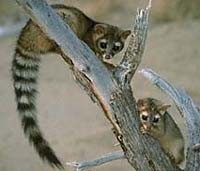Bassariscus
| Bassariscus | |
|---|---|
 | |
| Scientific classification | |
| Domain: | Eukaryota |
| Kingdom: | Animalia |
| Phylum: | Chordata |
| Class: | Mammalia |
| Order: | Carnivora |
| Family: | Procyonidae |
| Subfamily: | Procyoninae |
| Tribe: | Bassariscini |
| Genus: | Bassariscus Coues, 1887 |
| Type species | |
| Bassaris astuta[1] (Lichtenstein 1830) | |
| Species | |
| Bassariscus astutus | |
Bassariscus is a genus in the family Procyonidae. There are two extant species in the genus: the ringtail or ring-tailed cat (B. astutus) and the cacomistle (B. sumichrasti). Genetic studies have indicated that the closest relatives of Bassariscus are raccoons,[2][3][4] from which they diverged about 10 million years ago in the Tortonian Age of the Miocene.[4] The two lineages of Bassariscus are thought to have separated after only another two million years,[2] making it the extant procyonid genus with the earliest diversification. Later diversification in the genus in the Pliocene and Pleistocene saw the emergence of two extinct species, Bassariscus casei and Bassariscus sonoitensis, respectively. Due to the more digitigrade stance of their legs compared to the plantigrade stance of other members of Procyonidae, some taxonomies place the genus as a separate family, Bassaricidae..[5] The name is a Greek word for fox ("bassaris") with a Latinized diminutive ending ("-iscus").[6] The genus was named by Elliott Coues in 1887, having previously been described by Lichtenstein in 1830 under the name Bassaris. Coues proposed the word "bassarisk" as the English term for animals in this genus.[7] Its habitat includes semi-arid areas in the southwestern United States,[8] the whole of Mexico, as well as moist tropical forests in Central America.
Species
[edit]| Image | Scientific name | Common name | Distribution |
|---|---|---|---|
 | Bassariscus astutus | Ringtail | Southern United States from southern Oregon and California throughout the southwestern states to Texas. In Mexico it ranges from the northern desert state of Baja California to Oaxaca. Its distribution overlaps that of B. sumichrasti in the Mexican states of Guerrero, Oaxaca and Veracruz.[9] |
| † Bassariscus casei[10] | Case's ringtail[11] | An extinct species with fossils first found in the Upper Pliocene strata of the Rexroad formation in Kansas[12] and later in the Late Blancan strata in California.[11] | |
| † Bassariscus sonoitensis[10] | An extinct species with only three known locations in Papago Springs Cave, Santa Cruz County, Arizona (1942), San Josecito Cave, Nuevo León, Mexico (1958), and U-Bar Cave, Hidalgo County, New Mexico (1987), that lived from the late Pleistocene and went extinct before the full-glacial period of the late Wisconsinian.[13] | ||
 | Bassariscus sumichrasti | Cacomistle | Central America, from south central Mexico to Panama. |
References
[edit]- ^ Wilson, D. E.; Reeder, D. M., eds. (2005). "Genus Bassariscus". Mammal Species of the World: A Taxonomic and Geographic Reference (3rd ed.). Baltimore: Johns Hopkins University Press. ISBN 978-0-8018-8221-0. OCLC 62265494.
- ^ a b K.-P. Koepfli; M. E. Gompper; E. Eizirik; C.-C. Ho; L. Linden; J. E. Maldonado; R. K. Wayne (2007). "Phylogeny of the Procyonidae (Mammalia: Carvnivora): Molecules, morphology and the Great American Interchange". Molecular Phylogenetics and Evolution. 43 (3): 1076–1095. CiteSeerX 10.1.1.495.2618. doi:10.1016/j.ympev.2006.10.003. PMID 17174109.
- ^ Eizirik, E.; Murphy, W. J.; Koepfli, K.-P.; Johnson, W. E.; Dragoo, J. W.; Wayne, R. K.; O’Brien, S. J. (2010-02-04). "Pattern and timing of diversification of the mammalian order Carnivora inferred from multiple nuclear gene sequences". Molecular Phylogenetics and Evolution. 56 (1): 49–63. doi:10.1016/j.ympev.2010.01.033. PMC 7034395. PMID 20138220.
- ^ a b Helgen, K. M.; Pinto, M.; Kays, R.; Helgen, L.; Tsuchiya, M.; Quinn, A.; Wilson, D.; Maldonado, J. (2013-08-15). "Taxonomic revision of the olingos (Bassaricyon), with description of a new species, the Olinguito". ZooKeys (324): 1–83. doi:10.3897/zookeys.324.5827. PMC 3760134. PMID 24003317.
- ^ "Ringtailed Cat - Bassariscus astutus - DesertUSA". www.desertusa.com. Retrieved 2021-04-20.
- ^ "Definition of BASSARISCUS". Merriam-Webster. Retrieved 28 June 2018.
- ^ Coues, E. (1887). "Bassariscus, a new generic name in mammalogy". Science. 9 (225): 516. doi:10.1126/science.ns-9.225.516. PMID 17748409.
- ^ "Ringtail Cat". Archived from the original on 2010-08-10. Retrieved 2010-12-01.
- ^ Reid, F.; Schipper, J.; Timm, R. (2016). "Bassariscus astutus". IUCN Red List of Threatened Species. 2016: e.T41680A45215881. doi:10.2305/IUCN.UK.2016-1.RLTS.T41680A45215881.en. Retrieved 13 November 2021.
- ^ a b "Volume Issue 327 | Mammalian Species | Oxford Academic". 2017-05-25. Archived from the original on 2017-05-25. Retrieved 2021-04-20.
- ^ a b "Procyonidae - Raccoons and Ringtails | University of Texas El Paso".
- ^ Hibbard, C. W. (August 1952). "A new Bassariscus from the Upper Pliocene of Kansas|Journal of Mammalogy". 33 (3): 379–381. doi:10.2307/1375775. JSTOR 1375775.
{{cite journal}}: Cite journal requires|journal=(help) - ^ Harris, A. H. (October 1990). "Taxonomic Status of the Pleistocene Ringtail Bassariscus sonoitensis (Carnivora)|The Southwestern Naturalist". 35 (3): 343–346. doi:10.2307/3671953. JSTOR 3671953.
{{cite journal}}: Cite journal requires|journal=(help)
External links
[edit] Data related to Ringtail Cat at Wikispecies
Data related to Ringtail Cat at Wikispecies


 French
French Deutsch
Deutsch





